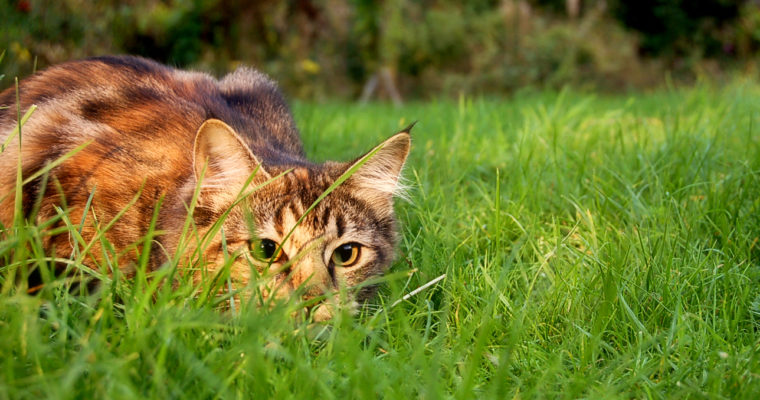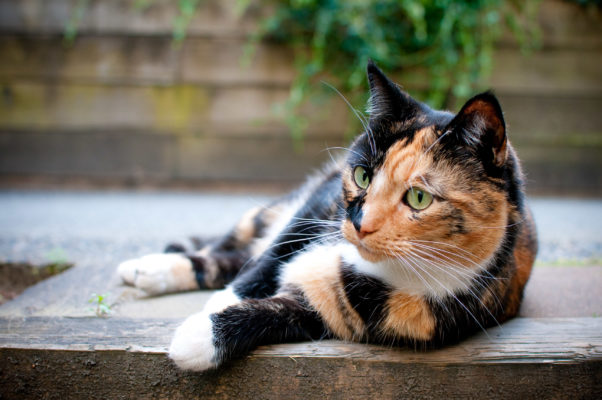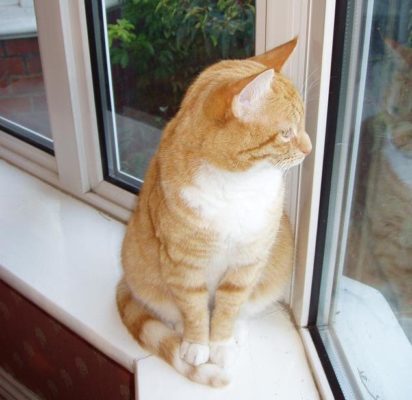Cats, cat management and the impact of cats on conservation – it seems that everyone in New Zealand has an opinion and a significant proportion of us own at least one companion cat – but what is actually known about the multiple roles of urban cats in New Zealand? It is becoming an increasingly important and hotly debated topic as conservation changes from being something that happens in remote locations to a growing urban restoration movement that’s happening in our city parks and our own backyards.

What are the proven facts? What are the gaps in our knowledge that need to be investigated so that rational debate and informed decisions can be made? What do we actually know about city cats?
Victoria University of Wellington researchers Heidy Kikillus and Geoff Chambers, along with Mark Farnworth and Kelly Hare have reviewed what we know – and what we don’t know – in an article just published in Pacific Conservation Biology. They’ve identified significant gaps in our current knowledge – and believe that cat owners can play a key role in aiding future research through corroborative ‘citizen science’ research projects. Researchers, conservationists and cat owners can all benefit from a better understanding of cats.

First of all – how many pet cats are there in New Zealand? We’re widely and frequently reported to have the highest recorded rate of cat ownership in the developed world – but when it comes to actually putting a figure on that, well… actually we can’t.
“…because no registration regulations exist for cats in New Zealand (as they do with dogs), no reliable population census of cat numbers exists. Two studies focused on the South Island cities of Dunedin and Christchurch estimated the percentages of households owning cats as 35% and 33% respectively. It is unknown whether the cat-ownership estimates in these cities are representative of all of New Zealand urban areas, especially small urban centres, and cities in the North Island, where infill housing and legislative restrictions mean fewer areas for larger companion animals (such as dogs), which may mean people are more likely to keep cats as pets.”
Cats kill native species – and kill other predators of native species – so how do the costs vs benefits balance out? What do city cats actually kill?
“The type of environment in which cats are located will affect the type(s) of prey captured. For example, in one study in Auckland, prey captured by cats in more ‘natural’ forested neighbourhoods consisted mostly of rodents, and was dramatically different from prey caught in purely urban areas (primarily invertebrates). Therefore, within urban environments, ecologists must take into account the differences among various available habitats. Cats have no natural predators in New Zealand; yet, they prey on a wide variety of smaller animals and may have impacts on native fauna. Yet cats may indirectly help native wildlife by keeping other introduced pests in check. Further research into the impacts of owned cats on prey populations (both introduced mammals and native wildlife) is warranted and a large database of prey captured by cats could be easily conducted via a citizen science smartphone app.”
When it comes to predation the debate can get seriously emotive. Some would portray all cats as lethal mass murderers, others claim that ‘Fluffy’ has never hurt a fly. Cats are famed for the individualistic natures and it seems that applies to their hunting preferences too.
“Consistent differences in behavioural syndromes have been well documented in numerous species of animals and, among cats, not all cats are avid predators. Investigation of factors influencing predatory behaviour and prey specialisation by cats (e.g. some target certain prey species, such as birds or rodents) could investigate factors such as the prey available in a given environment or genetic components of behavioural syndromes… For New Zealand cats, it appears that not all owned cats bring prey home, and, those that do, capture mainly rodents, followed by birds. For owners wanting to reduce capture of prey, while still leaving their cat free-to-roam, the purchase and use of anti-predation devices can be a desirable action.”
So how do New Zealand owners feel about bells on cat collars, other anti-predation devices, cat curfews and containment systems (catios)? Unlike many overseas cat-lovers, few New Zealanders currently keep their cats permanently contained. A change in attitude could potentially benefit cats (less fighting, road accidents and disease), wildlife – and business entrepreneurs.
“Overseas, the business of cats is a lucrative one, from containment/ indoor cat-keeping needs to cat anti-predator devices. Containment is a common practice overseas, preventing predation of wildlife, but also for the welfare of the cats themselves. In Tasmania, Australia, a survey of cat owners found that the most commonly reported barrier to containing pet cats was the belief that ‘it is natural behaviour for cats to wander so they should be allowed to do so’. How does this compare with the beliefs of New Zealand cat owners? A survey of 151 cat owners in New Zealand indicated that 95% of companion cats had free access to the outdoors, whereas a recent survey found that New Zealand cat owners had low support for 24-h containment of cats (18.6% of respondents). Further research to identify the drivers and barriers of pet-cat containment is warranted.”
So how exactly do you keep a cat contained on your own property? Unlike dogs they’re very good at jumping and climbing – and there are local body regulations about how high you can build your boundary fence.
“A Google search of the term ‘catio’ (a combination of the words ‘cat’ and ‘patio’, which is an enclosed outdoor area in which to contain cats) turns up multiple websites and businesses providing cat-containment equipment. However, if search results are filtered to only pages from New Zealand, the results are limited, with only one distributor selling cat-containment equipment in the country, and offering installation of the equipment only in the city of Auckland (Oscillot). Why do cat-containment systems appear to be unpopular in New Zealand when compared with other countries? What factors are preventing their widespread use and acceptance here? Are there business opportunities for overseas companies to provide cat containment solutions to the New Zealand public? Market research may help provide answers to these questions.”
It seems we’re also behind the times in New Zealand when it comes to anti-predation devices for cats – product design has moved well beyond the old ‘bell on collar’.
“In Dunedin, New Zealand, bells attached to domestic-cat collars reduced prey catch by half . Overseas, trials of various anti-predation products, such as the CatBib, sonic devices, and the Birdsbesafe collar cover have successfully reduced prey catch by owned cats when compared with control groups. Similar trials are urgently needed in New Zealand to test the effectiveness of these products and to investigate whether they are more effective than bells on collars. Of special interest are Birdsbesafe collar covers, which have overseas been shown to decrease bird and herpetofauna predation by over 50%, without significantly reducing the predation of small mammals. This is of great relevance to New Zealand, where native birds and herpetofauna are vulnerable to free-roaming cats, but where most small mammals in urban environments are introduced pests. However, although anti-predation devices may assist in mitigating the impacts of cats on native wildlife, they are not an ultimate solution because they do not address other issues, such as wandering cats (which may spread diseases and cause a nuisance to neighbours).”

Other areas identified by the authors for further research include the social benefits of cat ownership, risk of disease transfer from cats to humans, wildlife or other pets and more social research on our public attitudes to cats.
“Being such an emotive topic, any research and management of urban cats is going to raise debate among the public. Therefore, social research to help understand the public perception of cats in New Zealand is vital. Some research has begun, including investigating the use and perception of cat collars (cat owners preferred to use microchips for identification purposes); to the acceptability of unowned-cat control (respondents who owned cats perceived non-lethal control of unowned cats to be more acceptable than lethal control methods, when compared with non-owners).”
Cat owners aren’t the enemy of conservation – they have a key role to play in citizen-science. It’s to everyone’s benefit if discussion and decision-making are informed by fact and cats are less misunderstood on both sides of the debate.
“In order to explore the need for, and the subsequent effective management of urban cats in New Zealand, we need a clear understanding of their ecology, behaviour and impact on the local environment. Many of the ideas suggested in the present paper cannot be achieved without the full cooperation of cat owners themselves; therefore, many of these research projects have the ability to become large-scale citizen science programmes, with links to social, medical and ecological sciences. Cats are an important part of many human families and scientists need to refrain from accusing cat owners of being irresponsible and contributing to the decline of wildlife, instead providing evidence and facts that can be easily understood by citizens. Co-operative research programmes are likely to succeed by gathering data of benefit to researchers and cat owners, and of use by local and central government. Finding ways to increase public awareness about cat-management options and their ability to improve cat welfare and help mitigate cat impacts in New Zealand is also warranted.”
Meanwhile, as we learn more about the roles of cats – and research can take considerable time – we should consider, for our wildlife’s sake, erring on the side of caution.
“… we should continue to encourage responsible pet ownership and cat containment among New Zealanders, until the value of pet cats as companions and pest-removers outweighs the combined loss of individuals from native species and risk of owned cats becoming stray or feral (unowned). Urban ecologists will need to be versatile in the way that they design and conduct their experiments and data gathering, using a multidisciplinary and collaborative approach that brings the public along on the journey.”
The full research article is published in Pacific Conservation Biology and is freely available online:
Research challenges and conservation implications for urban cat management in New Zealand (2017)

